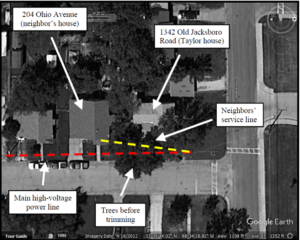$44 Million Dallas Verdict for Electric Shock

On April 18, 2023, a Dallas jury awarded $44 million in damages to a Texas homeowner who was rendered a paraplegic from an electric shock when trying to cut trim trees near a high-voltage power line. How did this happen?
The Taylors own a rental house on a corner lot in Graham, Texas. The Shifletts own the house next door. Both houses receive electrical power from lines owned and operated by Oncor Electric Delivery Company, LLC (Oncor). A 7,200 volt uninsulated power line runs to the corner of the Taylors’ property and two 240 volt insulated service lines, one running to the Taylors’ house and one to the Shifletts’ house, branch off from the pole. Although the service line to the Shifletts’ house runs over the Taylors’ property, Oncor never obtained an easement for that line. A picture of the lines and locations of the houses, as contained in the live complaint, is shown below.
The Taylors and Shifletts began experiencing disruptions to their electrical service due to several hackberry trees growing around and over the lines. Beginning in April 2015, the Taylors contacted Oncor at least 4 times to request that Oncor inspect the lines and trim the trees. On at least one occasion, the Taylors requested Oncor remove the Shifletts’ service line from the Taylors’ property. Oncor refused all the Taylors’ requests, instead informing the Taylors and their tenants that the Taylors had responsibility for trimming the trees.
The Taylors contacted private companies to trim the trees, but were unable to find a company willing to perform the work due to the proximity of the trees to the power lines. In May 2015, failing to obtain relief from Oncor or a private company to perform the work, the Taylors used a boom lift to trim the trees. While doing so, Stacy Taylor received an electric shock, rendering him a paraplegic. Notably, Oncor moved the Shifletts’ service line in 2017 after the trees damaged the line and nearly started a fire in the Shifletts’ house.
Stacy Taylor filed suit against Oncor in Dallas District Court in 2016 alleging negligence, negligence per se, premises liability, trespass, nuisance and violations of the Deceptive Trade Practices—Consumer Protection Act (DTPA) and seeking $75 million in damages. Oncor argued the Shifletts, not Taylor, were responsible for maintaining the service line and Taylor wanted to cut down the tree entirely not just trim the branches near the service wire. Oncor also argued that under Chapter 752 of the Texas Health and Safety Code, Taylor was required to give Oncor notice of his intent to work in the vicinity on the power lines. To counter Taylor’s claims that Oncor lacked an easement or permission to run the Shiflletts’ service line across the Taylors’ property, Oncor argued that it had a prescriptive easement for the service line.
The jury rejected Oncor’s arguments, finding Oncor negligent and in violation of the DTPA, and allocated 75% responsibility to Oncor and the remaining 25% to Taylor. The jury awarded Taylor $4 million for past pain and suffering, $10 million for future pain and suffering, $1.52 in past and future loss of earnings, $2 million for past disfigurement, $1 million for future disfigurement, $8 million for past impairment, $10 million for future impairment, $5.1 for past and future medical expenses, and $3.5 million for Oncor’s unconscionable conduct and knowing violation of the DTPA. The jury also found that Oncor had a prescriptive easement for the Shifletts’ service line, but that Taylor’s violation of Chapter 752 was excused.
There is an old adage that bad facts make bad law. The facts surrounding Taylor’s injury and the severity of those injuries clearly influenced the jury’s decision and caused them to award significant damages. The attorneys in our Austin and Dallas offices have significant experience identifying the good, bad and ugly facts and providing timely analysis of exposure to our clients. If you should have any questions, please contact us at info@gstexlaw.com.
Legal Disclaimers
This blog is made available by Gerstle Snelson, LLP for educational purposes and to provide general information about the law, only. Neither this document nor the information contained in it is intended to constitute legal advice on any specific matter or of a general nature. Use of the blog does not create an attorney-client relationship with Gerstle Snelson, LLP where one does not already exist with the firm. This blog should not be used a substitute for competent legal advice from a licensed attorney.
©Gerstle Snelson, LLP 2023. All rights reserved. Any unauthorized reprint or use of this material is prohibited. No part of this blog may be reproduced or transmitted in any form or by any means, electronic or mechanical, including photocopying, recording, or by any information storage or retrieval system without the express written permission of Gerstle Snelson, LLP.


